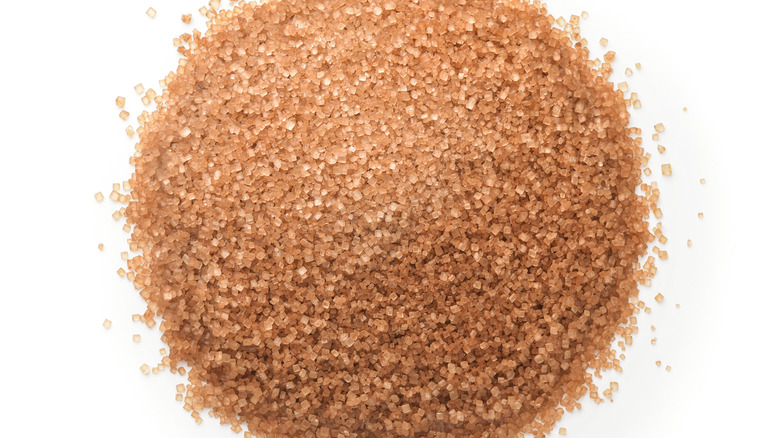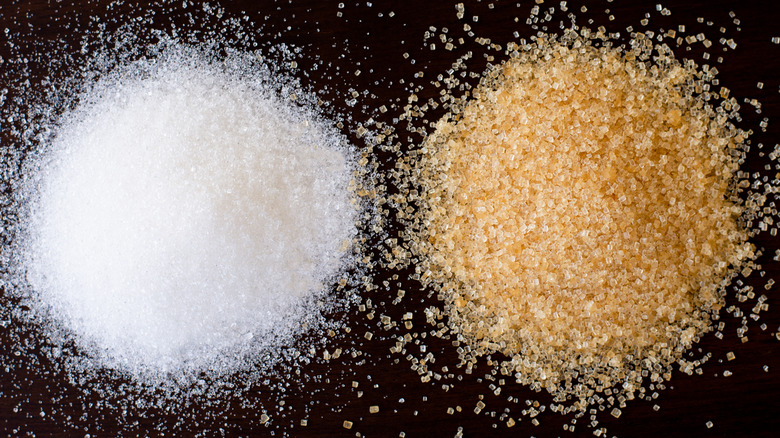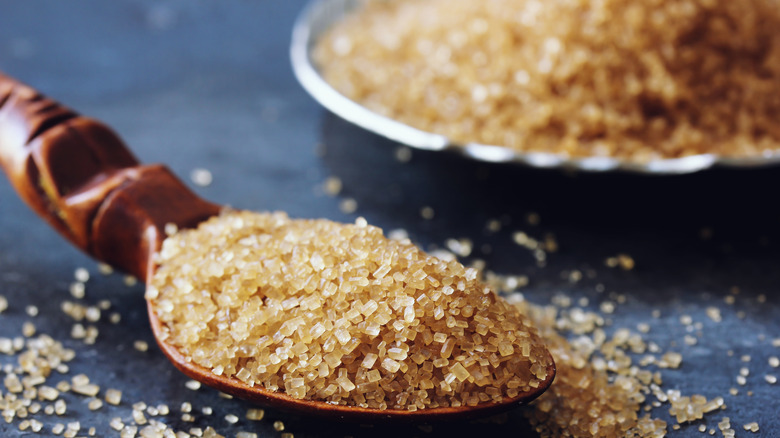What Sets Turbinado Sugar Apart From Other Refined Sugar
What makes Ina Garten's Perfect Pound Cake so perfect? Some might say it's the fact that the recipe makes two loaves — one for now and one for later. Or, if you're feeling more formal or festive, you can make it as a big Bundt cake. Others would say it's the subtle vanilla-orange fragrance and flavor of the cake, which makes it worth the effort of zesting two oranges (per Barefoot Contessa). And still, you might think it's the golden, tender interior of the cake, a delightful contrast to the brown and crackly exterior, which gets its crunch from coating the prepared cake pan with turbinado sugar before adding the batter.
Recipe developer and cookbook author Alexis deBoschnek was so taken with Garten's cake and its sugar-coated crust when she tried it for The Kitchn that she recommended adding extra turbinado sugar to the pan: "The turbinado sugar adds such a good textural contrast to the crumb that you really don't want to skip out on it.”
You might, at this point, be wondering — what the heck is turbinado sugar? You might have walked past it in the baking aisle. For some bakers, coarse brown turbinado sugar is the crowning glory to quick bread, brownies, cookies, and cakes — and warrants its own canister in the kitchen.
Turbinado sugar is not the same as brown sugar
Granulated sugar, brown sugar, and turbinado sugar are often stocked side-by-side at the grocery store, but these three types of sugars are different from each other and shouldn't be used interchangeably (per MasterClass). What makes turbinado sugar distinct is its light brown color — a sign of the presence of molasses — and its rough, choppy crystals. Turbinado sugar is more minimally processed than regular sugar, which has the molasses completely removed from it leaving it a bright white color (via SFGATE). Brown sugar, in a nutshell, is processed white sugar with some of the molasses returned to it. It's darker, softer, and more full-flavored than turbinado sugar and gives baked goods like cookies some chew.
If you're a Starbucks devotee, you've probably seen turbinado sugar in brown packets labeled Sugar in the Raw while fixing your coffee. Recipe testing expert Jack Bishop of America's Test Kitchen uses turbinado for sprinkling on top of muffins and for a creme brulee crust — and he encourages home bakers to keep a box of it on hand stating it's "the best choice." The sugar is great for sweet and crunchy embellishment to cookies, cakes, and quick breads.
Think of turbinado sugar as a finishing sugar
Turbinado sugar can be used in recipes, just like white sugar, but it does really outstanding work on foods, as a finishing sugar. Think of it as you would a gourmet finishing salt, like flaky, rough-around-the-edges Maldon salt. Deb Perelman, creator of the popular Smitten Kitchen blog and the author of several cookbooks, including, most recently, "Smitten Kitchen Keepers” (per Smitten Kitchen), wouldn't dream of topping her go-to blueberry muffins with anything other than turbinado sugar. Why? White sugar will melt or disappear into the batter, but sturdy turbinado sugar "creates a towering, crunchy, and bronzed lid on top” (per People).
Martha Stewart-approved uses for granulated brown sugar include classic, chewy molasses crinkle cookies rolled in turbinado sugar for a bit of crunch on the finish (per PBS). The TV host and cookbook author also keeps turbinado handy for cocktail hour, including an apple cider drink spiked with bourbon and rimmed with robust turbinado sugar. Yum!


